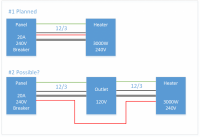borisf
New Member
I'm planning to add a hard-wired infrared patio heater soon. [Infratech SL-30 if anyone has any feedback on this unit].
It's a 3000W 240V heater and I'm going to add a dedicated 20A 240V breaker for it. The heater location is a ways from the panel (~60 ft.) and it would be very convenient to add a standard 120V outlet to the deck as part of the same wiring run.
Is it to code to use one of the 240V legs that runs to the heater for this 120V outlet and share the ground and neutral? See attached diagram.
It's a 3000W 240V heater and I'm going to add a dedicated 20A 240V breaker for it. The heater location is a ways from the panel (~60 ft.) and it would be very convenient to add a standard 120V outlet to the deck as part of the same wiring run.
Is it to code to use one of the 240V legs that runs to the heater for this 120V outlet and share the ground and neutral? See attached diagram.

